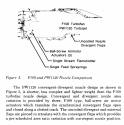You are using an out of date browser. It may not display this or other websites correctly.
You should upgrade or use an alternative browser.
You should upgrade or use an alternative browser.
J-10 Thread IV
- Thread starter Jeff Head
- Start date
Newly produced J-10S starting flight test in CAC.
View attachment 49632
Would be interesting to know its production batch.
So the underlying principle of this TVC nozzle seems to be quite similar to US MATV nozzle, tested on one F-16 in early 1990s. Main visible difference being the Chinese engine has added moving points on the ends of the outer petals, making them in essence two part outer petals. Inner petals still seem to be one piece. MATV had similar looking inner petals and simpler one piece outer petals. Can't find good images of EJ-200 TVC testbed engine though, to compare that as well...
P&W PYBBN, GE AVEN (MATV), Salyut's nozzle, KliVT... they're all minor variations on the same basic principle, in the same way that GE's and P&W's non-TVC nozzles aren't fundamentally different. Given the two-part outer petals, the closest counterpart to this new Chinese nozzle is Salyut's design. It may be a result of using a short divergent nozzle section similar to the PW1120 (Lavi engine) for lower weight while accepting a certain thrust penalty:

Doesn't explain why Salyut does it though, their divergent section seems to be of regular length.
As for Eurojet's TVN, that design was a simplified variant of the PYBBN/AVEN etc. concept which removed the requirement for separate throat & exit area unison rings by splitting the single remaining ring into upper and lower halves joined by a hinge. These could 'wink' like eyelids to control exit area, with the drawback that exit cross section did not always remain perfectly circular (small thrust penalty).
As I recall an article about the J-10’s TVC nozzle that came out when it first showed up said that the nozzle design was supposed to both save on weight and minimize thrust penalty.P&W PYBBN, GE AVEN (MATV), Salyut's nozzle, KliVT... they're all minor variations on the same basic principle, in the same way that GE's and P&W's non-TVC nozzles aren't fundamentally different. Given the two-part outer petals, the closest counterpart to this new Chinese nozzle is Salyut's design. It may be a result of using a short divergent nozzle section similar to the PW1120 (Lavi engine) for lower weight while accepting a certain thrust penalty:
View attachment 49641
Doesn't explain why Salyut does it though, their divergent section seems to be of regular length.
As for Eurojet's TVN, that design was a simplified variant of the PYBBN/AVEN etc. concept which removed the requirement for separate throat & exit area unison rings by splitting the single remaining ring into upper and lower halves joined by a hinge. These could 'wink' like eyelids to control exit area, with the drawback that exit cross section did not always remain perfectly circular (small thrust penalty).
It's always a compromise between weight, thrust penalty and complexity/cost. If minimizing thrust losses is the paramount concern, Saturn's ball joint solution is probably the gold standard: all cross sections always remain circular, long divergent section, independent exit area control (although the latter is a feature of all the TVC nozzles discussed here). Requires loads of actuators though.
A version of Eurojet's design with a WS-10/PW1120-style short divergent section would sit at the opposite end of the spectrum (weight/complexity optimal, higher thrust penalty).
A version of Eurojet's design with a WS-10/PW1120-style short divergent section would sit at the opposite end of the spectrum (weight/complexity optimal, higher thrust penalty).
Why? It shouldn’t be surprising if China has better radars than Russia now. They have a far more dominant and world leading radio technology industry. The expertise is there.
The USSR had virtually no non-military RF industry and zero access to COTS electronics, yet kept pace pretty well. It's an unreliable indicator.
I’m not using that point to argue for why we should expect Russia’s military RF capabilities to be behind China, but why we shouldn’t expect China’s to be behind Russia’s. Totally different uses of the point.The USSR had virtually no non-military RF industry and zero access to COTS electronics, yet kept pace pretty well. It's an unreliable indicator.
Or the divergent section is no shorter than it should be. But the reason of two section outer petal is simply because of the different location of the bar attachment, see the red circle.P&W PYBBN, GE AVEN (MATV), Salyut's nozzle, KliVT... they're all minor variations on the same basic principle, in the same way that GE's and P&W's non-TVC nozzles aren't fundamentally different. Given the two-part outer petals, the closest counterpart to this new Chinese nozzle is Salyut's design. It may be a result of using a short divergent nozzle section similar to the PW1120 (Lavi engine) for lower weight while accepting a certain thrust penalty:
View attachment 49641
Doesn't explain why Salyut does it though, their divergent section seems to be of regular length.
As for Eurojet's TVN, that design was a simplified variant of the PYBBN/AVEN etc. concept which removed the requirement for separate throat & exit area unison rings by splitting the single remaining ring into upper and lower halves joined by a hinge. These could 'wink' like eyelids to control exit area, with the drawback that exit cross section did not always remain perfectly circular (small thrust penalty).




